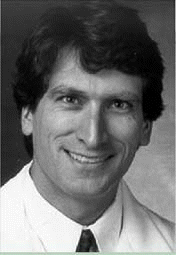WASHINGTON, DC-Practice guidelines have recently been developed for patients with thyroid nodules and differentiated thyroid cancer. David S. Cooper, MD, Director of the Division of Endocrinology at Sinai Hospital and Professor of Medicine in the Division of Endocrinology at Johns Hopkins University School of Medicine in Baltimore, who chaired the committee that developed the guidelines, participated in a panel discussion about the guidelines at the recent AAO-HNS Annual Meeting.
Explore This Issue
December 2007 David L. Steward, MD, said that ultrasound-guided fine needle aspiration can be performed in the office at a patient’s initial visit.
David L. Steward, MD, said that ultrasound-guided fine needle aspiration can be performed in the office at a patient’s initial visit.Scope of the Problem
Thyroid nodules are common-present in about 5% in women and 1% in men living in iodine-sufficient parts of the world. However, the prevalence is likely higher because high-resolution ultrasound can detect thyroid nodules in 19% to 67% of randomly selected individuals. The clinical problem is to isolate the 5% to 10% of these nodules that are malignant.
Differentiated thyroid cancer, which includes papillary and follicular carcinoma, comprises the vast majority (90%) of all thyroid cancers in the United States-about 33,500 cases predicted in 2007, a number that is slowly and steadily increasing.
Over the past decade there have been many advances in diagnosis and treatment of thyroid nodules and differentiated thyroid cancer. Controversies exist about the most cost-effective approach to diagnosis, the extent of surgery for small cancers, use of radioactive iodine to ablate remnant tissue after thyroidectomy, appropriate use of thyroxine suppression therapy, and the role of recombinant human thyrotropin.
For all these reasons, the American Thyroid Association formed a task force to examine current strategies and to develop clinical guidelines using principles of evidence-based medicine. (Management guidelines for patients with thyroid nodules and differentiated thyroid cancer. Thyroid 2006 Feb;16(2):109-42, available online at www.thyroid.org .)
Thyroid Nodules
A thyroid nodule is a discrete lesion within the gland that is palpably and/or ultrasonographically distinct from the surrounding thyroid parenchyma. (However, nonpalpable nodules have the same risk of malignancy as palpable ones of the same size.) Generally, only nodules larger than 1 cm should be evaluated, because they have the potential for clinically significant cancers. Appropriate evaluation consists of:
- History and physical exam, focusing on the thyroid gland and adjacent cervical lymph nodes, and looking for a history of head and neck irradiation, total body irradiation, first-degree family history of thyroid cancer, and exposure to nuclear fallout.
- Serum thyrotropin (TSH). There is some evidence that high preoperative TSH may predict a higher sensitivity for postoperative surveillance with TSH, but it is not known how this would affect patient management.
- If TSH is suppressed, radionuclide thyroid scan to determine if the nodule is autonomously functioning, and therefore most likely benign.
- Thyroid ultrasound to determine if the size and location of the nodule corresponds to what was discovered on palpation, as well as to see if there are other nonpalpable nodules.
- Serum calcitonin measurement to detect early C-cell hyperplasia and medullary thyroid cancer is not recommended in the current ATA guidelines because of lack of data on cost-effectiveness.
- FNA biopsy, the most accurate and cost-effective method to evaluate thyroid nodules. Results are divided into four categories: benign (the most common reading), indeterminate or suspicious for neoplasm, nondiagnostic, and malignant (5-10%).
Patients with multiple thyroid nodules have the same risk of malignancy as those with solitary nodules, and a diagnostic ultrasound should be performed to delineate the nodules. Nodules with suspicious sonographic features (hypoechoic, calcifications, indistinct borders, high blood flow on Doppler) should be biopsied first. A new study presented at the AAO-HNS meeting showed that in 447 office-based fine-needle aspiration (FNA) biopsies of the thyroid gland (using ultrasound-guided fine needle aspiration, or US-FNA), more than 92% resulted in an adequate specimen, thus saving patients a visit to the hospital for the procedure. These findings suggest that US-FNA can be performed in the office at a patient’s initial visit, said the study’s lead author, David L. Steward, MD, Associate Professor in the Department of Otolaryngology and Director of the Clinical Trials Program at the University of Cincinnati.
Leave a Reply